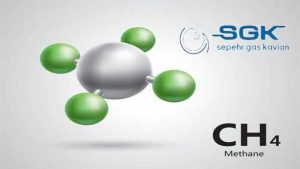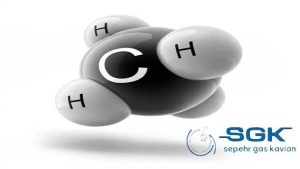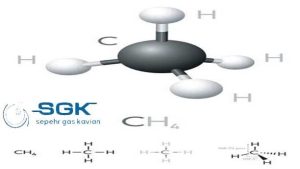Methane gas
Methane gas (CH₄) is a colorless, odorless gas that is the simplest alkane and the main constituent of natural gas. It is also a greenhouse gas (GHG) that is more potent than carbon dioxide at trapping heat in the atmosphere.
Sepehr Gas Kavian Company is the reference laboratory of the Standards Department, the holder of the ISO17025 certificate, the producer of all kinds of pure gases and their mixtures. One of these pure gases is pure methane gas with a high purity percentage. Also, Sepehr Gas Kavian is able to measure hydrocarbon and non-hydrocarbon gases and gas mixtures by means of gas chromatography. At Sepher gas kavian, laboratory pure methane gas is sold with high quality and reasonable price along with a valid certificate.

Resources
There are two main sources of this gas:
natural and anthropogenic.
Natural sources of CH4 gas include:
Wetlands: Wetlands are the largest natural source of methane gas. This gas is produced by the decomposition of organic matter in wetlands, such as plants, algae, and bacteria.
Ruminant animals: Ruminant animals, such as cows, sheep, and goats, produce this gas as part of their digestion process. This gas is produced when bacteria in the animal’s stomach break down plant matter.
Oceans: CH4 is also produced in the oceans by the decomposition of organic matter. However, the amount of this gas produced by the oceans is relatively small compared to the amount produced by wetlands and ruminant animals.
Gas hydrates: Gas hydrates are ice-like solids that contain this gas trapped in a lattice of water molecules. Gas hydrates are found in marine sediments and permafrost.
Anthropogenic sources of this gas include:
Oil and gas production: This gas is produced during the extraction, processing, and transportation of oil and gas.
Agriculture: This gas is produced during the production of agricultural products, such as rice, livestock manure, and wastewater treatment.
Waste disposal: CH4 is produced in landfills as organic matter decomposes.
Other industrial processes: This gas is also produced by some industrial processes, such as coal mining and the production of plastics.
Technical specification
| Chemical formula | CH4 |
| Molecular weight | 16.04 g/mol |
| Boiling point | -161.5 °C |
| Melting point | -182.5 °C |
| Density | 0.717 g/L (at STP) |
| Specific heat capacity | 2.26 J/g/°C |
| Flammability limits | 5.0% – 15.0% |
| Odor | Odorless |
| Color | Colorless |
| Vapor pressure | 1.013 bar (at 20 °C) |
| Toxicity | Non-toxic |

Application
This gas has a variety of applications, including:
Fuel: This gas is a clean-burning fuel that can be used for a variety of purposes, including heating, cooking, and power generation. It is also a potential fuel for transportation, and it is being used in some buses and cars.
Chemical feedstock: This gas can be used to produce a variety of chemicals, including methanol, ammonia, and plastics. It is also a potential feedstock for the production of hydrogen.
Refrigerant: CH4 can be used as a refrigerant. It is a more environmentally friendly alternative to some other refrigerants, such as CFCs and HFCs.
Energy storage: This gas can be stored and used as a source of energy. This is known as compressed natural gas (CNG) or liquefied natural gas (LNG). CNG and LNG are becoming increasingly popular as alternative fuels for transportation.
Other applications: This gas can also be used in a variety of other applications, including mining, metalworking, and glassmaking.
CH4 is a versatile gas with a number of potential applications. As the demand for clean energy grows, this gas is likely to become an even more important fuel and feedstock in the future.

Danger
The dangers of this gas can be divided into two categories: physical dangers and health dangers.
Physical dangers of this gas
Fire and explosion: CH4 is a highly flammable gas, and it can form explosive mixtures with air. If this gas is ignited, it can cause a fire or explosion.
Asphyxiation: This gas is a less dense than air, so it can displace oxygen in enclosed spaces. If CH4 accumulates in an enclosed space, it can displace oxygen and cause asphyxiation.
Liquefied natural gas (LNG): LNG is a form of methane that has been liquefied by cooling it to very low temperatures. LNG is more dangerous than gaseous methane because it is more volatile and can easily vaporize. If LNG is spilled, it can vaporize quickly and form an explosive mixture with air.
Health dangers of this gas
Short-term exposure: Short-term exposure to CH4 can cause symptoms such as headaches, dizziness, nausea, and vomiting. In severe cases, it can lead to unconsciousness and death.
Long-term exposure: Long-term exposure to methane gas can cause health problems such as respiratory problems, neurological problems, and cancer.





